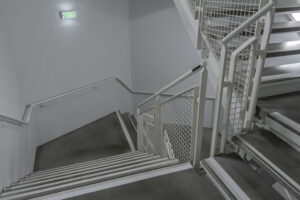Blog
- Home
- Resources
- Bright Ideas Blog
- The Building Engineer’s Guide to Lighting Commercial Stairwells
The Building Engineer’s Guide to Lighting Commercial Stairwells

No one wants to be in a dark stairwell. Not only can it be dangerous and lead to injury, but it can also make people feel unsafe and uncomfortable. Properly lighting commercial stairwells, both inside and outside, can make a huge difference in both appeal and safety. Although commercial stairwells are occupied infrequently and for short periods of time, appropriate illumination is necessary for a person to be able to navigate through a building under all conditions.
Read on for a guide on commercial stairwell regulations, upgrade opportunities, and lighting tips.
Current Stairwell Lighting Regulations
- For commercial stairwells, the minimum light levels required is 1 foot-candle (fc), but new guidelines for new stairways (in new constructions) state levels should be no less than 10 fc measured on the floor (NFPA 101 Life Safety Code).
There are some exceptions, such as performance areas during the course of a performance, but most commercial stairwells must adhere to these regulations.
- Stairwells are required to be lit even in event of power outage, either via a backup power generator or batteries, with a 10 fc minimum. Lights must be on for a minimum of 90 minutes.
- If stairs encompass more than six stair treads, there must be light switches at the top and bottom of the stairway (except where remote, central, or automatic control of lighting is provided).
- If using dimmers and/or sensors, lights must remain on for at least 15 minutes after occupancy.
Energy Efficiency Opportunities for Commercial Stairwells
Because commercial stairwells are traditionally designed to operate 24 hours/day, utility costs can add up quickly, especially when there are multiple floors, stairwells, and landings in one building.The easiest way to get more control and save energy and money is to convert to LED. Doing so can result in up to 80-90% energy savings (average of one lighting fixture per 58 square feet). They last longer, requiring less maintenance time and money. Plus, they can also reduce the heat given off a fixture which can keep stairways cooler and help prevent overheating and fire hazards.
Another way is to use occupancy sensors or step-dimming sensors, which can reduce lighting to a lower level to decrease energy consumption. However, keep in mind that regulations state the sensors/dimmers must still keep lights on for at least 15 minutes after the space becomes unoccupied.
There are several different options here including step dimming, continuous dimming or switching, low-end dim levels, integral or external sensors, and daylight sensing.
Whether you’re planning to convert to LED or use sensors or dimmers, you can replace just singular bulbs or entire fixtures/systems. While the entire system may cost more up front, you’ll be saving money over time through lower energy and maintenance costs.
Tips For Lighting Commercial Stairwells
- Consider the style you want. Will the stairs be used heavily? Do you want the stairway lighting to confirm to the aesthetics of the rest of the building? Or be more economical? Do you prefer a white or clear lens? Wall or ceiling mounted? What lamp length? What wattage? Answers to these questions are a good way to get started thinking about how your lighting will look.
- Know the lighting exposure. Where are the lights going to be in the stairwell? Do they need wire guards to protect the lenses? If the stairways are outside, do you want weather-resistant covers or styles? Do you need to be concerned about vandal-reducing features? Considering these factors in the beginning will help save you from having to replace lighting in the near future.
- Factor in light distribution. Light distribution is the amount of area a single light fixture will cover. Having an estimate of light distribution you need can heavily impact the total cost. Additionally, if you’re planning on using dimmers or sensors, you must make sure the sensors are sensitive enough to raise the light output immediately upon occupancy, avoiding “blind spots” that can be unsafe.
- Think about the stairwell occupancy. How often will people be in these stairwells? During normal business hours? 24 hours per day? Perhaps you want to consider occupancy sensors or bi-level dimming sensors, both of which can increase savings and extend the life of the fixtures.
- Have a backup plan. Lights must still work even if there’s a power outage, and especially in the event of an emergency. Have a plan for whether you’ll have battery backups, generators, or other systems to ensure you have light in emergent situations.
Lighting Defects to Look Out For
Whether planning lighting for commercial stairwells or inspecting those that already exist, there are some defects to look out for and avoid, such as:
- Interior light fixtures or switches not weather protected.
- Fixtures are not present at both the top and bottom of the stairs (when required) or are not three-way (allowing someone to turn stairs on and off from both switches).
- Light switches are not properly located.
- Stair lights are burned out, damaged, or otherwise not working.
- Stair or landing lighting are too dim (insufficient lumens).
- There is a stair or landing light that intrudes into the walking space (so that someone could run into the light/bulb).
Consult The Experts
Bay Lighting provides commercial lighting solutions in Maryland, Washington DC, and Northern Virginia. Our areas of expertise are for commercial and residential property management companies, and LED retrofits and installations are available.
Whether you’re building new or looking to upgrade a commercial stairwell, we can provide the guidance and knowledge necessary for a successful project. Call us today at 301-858-9494 or fill out our online contact form.




